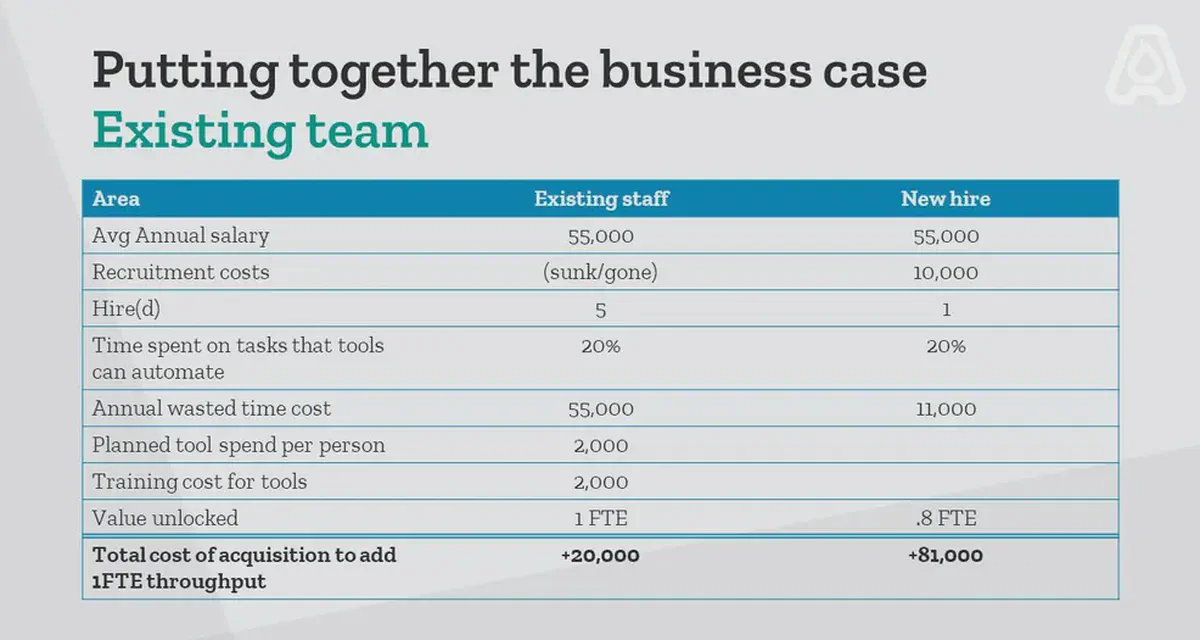
Investing in tools scales staff productivity
- Steph Locke
- July 23, 2021
Table of Contents
Nearly every manufacturer is feeling the pressure of a labour shortage. As baby boomers retire and millennials prefer to work in other industries, manufacturers have had to decrease production or spend more money on recruiting and training. But what if I told you that there is an answer? There are digital tools out there that can help you scale your staff productivity with little-to-no cost investment.
The most important thing about investing in these kinds of tools for your company is that they allow you to do more with less by automating repetitive tasks so employees don’t need as much time per task. This means that even though each employee costs more than someone who doesn’t use these types of tools, it’s still worth it because those employees are able to handle far more work overall.
It’s not just about saving money on recruiting and training. You’ll be able to do more with the same amount of staff, meaning you can create a more efficient supply chain because tasks are being done in less time. This will also lead to faster delivery times for customers which means they’re going to be happier and so will your bottom line.
The business case
Today, there is a wealth of no-code AI-powered automation options available to help manufacturers digitally transform their operations to better scale. We believe in the business benefit from this route for manufacturers (indeed, it’s our entire business model!) so we wanted to share the business case for the investment to help make it clearer why this investment in time and cash in tools is good for your business.
Our research shows that best-in-class tools are the top contributor to business success—enabling greater productivity, visibility, and coordination. Yet only 5 percent of executives recognized this link and ranked tools among their top-three software enablers. Microsoft
Start with your existing team
Let’s start with the use case of an existing team. You want to be able to add 1 Full Time Employee (FTE) equivalent of throughput to your team.
Your options are to hire a new person or to look for productivity gains in the team. You ask them, and as they don’t have a lot of tools right now, the team thinks they spend 20% of their time on stuff tools can automate.
So, if you can automate 20% of the work for 5 team members, you can get 1FTE extra whilst only spending the cash to buy the tools and maybe even splurge on training to ensure they’re using the tools well.
Contrast that with a new hire. To hire a new person, you usually not only have to pay their full salary but pay some recruitment costs. These could be to a recruiter, or they could just be the huge amount of your time spent on filtering CVs, interviewing, contract negotiating, liaising with HR and so on. You hire this person and because they too have no tools, you don’t actually get 1FTE. You get 0.8FTE! You’d have to hire one and a bit people to actually achieve the goal.
Putting some hypothetical numbers against these two cases, it can cost 4 times more on upskilling new hires that it could to unlock productivity for your existing team.
| Area | Existing staff | New hire |
|---|---|---|
| Avg Annual salary | 30000 | 30000 |
| Recruitment costs | 0 | 4500 |
| Hire(d) | 5 | 1 |
| Time spent on tasks that tools can automate | 20% | 20% |
| Annual wasted time cost | 30000 | 6900 |
| Planned tool spend per person | 1000 | |
| Training cost for tools | 1000 | |
| Value unlocked (FTE) | 1 | 0.8 |
| Total cost of acquisition to add throughput | 10000 | 43125 |
Retain staff for longer
The study from Microsoft & McKinsey, found that investment in tools improves satisfaction and improves retention by 47%.
In the scenario below, we have our original 5 staff and over 6 years maintain the headcount. For pessimism’s sake I’ve assumed we have to buy everyone who starts tools again, even though licenses typically can be reassigned. Even with an extra outlay for tools and training on each new hire, it still costs less than the costs incurred by additional recruitment for higher churn.
| Area | Without tools | With tools |
|---|---|---|
| Headcount | 5 | 5 |
| Avg annual salary | 30000 | 30000 |
| Recruitment costs | 4500 | 4500 |
| Tools & training spend per person | 0 | 2000 |
| Average tenure (years) | 2 | 3 |
| Time period (years) | 6 | 6 |
| Refill hires | 15 | 10 |
| Total cost to hire | 67500 | 65000 |
Scale becomes cheaper
Whenever an organization becomes technologically advanced, it will eventually reach a point where the cost-benefit trade-off once again makes it cheaper to hire than continue automating. You’ll need to hire eventually if you want to keep adding throughput. Because of tooling and your investment, as your company grows you’ll need fewer staff than you would otherwise for throughput gains due to lower wasted time.
Let’s say you want to add 5FTE more throughput to your team and you use existing team’s performance as your benchmark. Without tools, each staff member is 0.8 FTE but with tools they’re 1FTE. You’ll need to hire 6 people instead of 5 to get roughly 5FTE if you don’t invest in tools. Even taking into account the cost of tools, you still save one headcount worth of salary.
| Area | New hire | New hire with tools |
|---|---|---|
| Avg Annual salary | 30000 | 30000 |
| Recruitment costs | 4500 | 4500 |
| Hire(d) | 6 | 5 |
| Tool automatable tasks | 20% | 0% |
| Annual wasted time cost | 36000 | 0 |
| Planned tool spend per person | 1000 | |
| Tool training cost per person | 1000 | |
| Value unlocked (FTE) | 4.8 | 5 |
| Total cost of acquisition to add throughput | 207000 | 182500 |
Build your own business case
We put together a very quick and easily modifiable business case calculator for you to add in your salaries, automation ratios, and planned spend to help gauge the return on investment you can get.
Download the business case spreadsheet and give it a go!
Tool quick wins
- Be The Change: Standing up for equality
Be The Change is an event series run by Tramshed Tech that aims to highlight partners who are advocating change, support collaboration for change-making action, and ensure the equality agenda across all protected characteristic groups remains current and in the spotlight. The idea is to raise awareness for underrepresented groups and create individual connections.
- How to score your first AI quick wins: Intelligent Insights
There’s no doubt that going ahead with Artificial Intelligence (AI) can be risky. We’ve seen numerous AI fails from major companies including IBM, Amazon and Microsoft which landed them in hot water, something big companies can often bounce back from, but could be more of a problem for the smaller players. The trick to getting started with AI is to start small, which is where our quick win AI projects come into play.
- How to score your first AI quick wins: Social Listening
Marketing is a ripe area for Artificial Intelligence (AI) adoption, with all the data and the insights, but how do you make the jump into the AI pool when you look around and all you see is resistance? Quick win projects are an essential tool for building confidence among your team, particularly when introducing new concepts. That is why Nightingale HQ have created a guide of quick-win projects to help departments and companies ease into AI and build momentum for future, more complex projects. In this edition, we will discuss the benefits of practising social listening and how to pull it off as your first AI win.
- How to score your first AI quick wins: Knowledge Worker Productivity
When you choose to introduce Artificial Intelligence (AI) in your organisation or department there can be a lot of resistance and uncertainty, which is why it is important to start small and win fast. By taking on smaller fail-proof projects, you can build up confidence among your team as they begin to see the value of the projects and stop fearing failure and resisting changes. In this project we discuss how to boost knowledge worker productivity, something employees will be able to track themselves and see the true value of. Building momentum in this way will pave the way for greater successes down the line.
- How to score your first AI quick wins: Sales AI
Making big changes in your organisation or department such as kick-starting Artificial Intelligence (AI) can be a risky move if things don’t go to plan. Getting your team on board from the start is key to longterm success, which is why it’s so important to have an easy way in, such as one of our quick win AI projects. Not only do quick wins provide immediate value for your company or department, but they help build momentum among your team and change attitudes toward your projects. In this edition, we will discuss how to infuse your sales process with AI for ultimate results.
- How to score your first AI quick wins: Accessible meetings
Artificial Intelligence (AI) can come across as a make or break move, perhaps a risky step, particularly if you don’t have disposable resources, which is why it is so important to start with some quick win projects in order to build confidence and momentum within the company. The sure success of a quick win project removes the pressure for following projects where there might be more at stake, but they also bring immediate value to your business.
- How to score your first AI quick wins: FAQ chatbots
AIFightsBack webinar Augmenting Customer Service with Chatbots 16 April at 15.00 is now over. Check out our video and slide here
- 7 tips for building a data culture that will strengthen your business
Data analytics has taken off but not everyone is on the same page. While some companies are already making waves with data science, others are still struggling with the basics. Curating a healthy data culture is ever more important now to prevent the gap from growing between those who are embracing analytics and those who are lagging behind.


